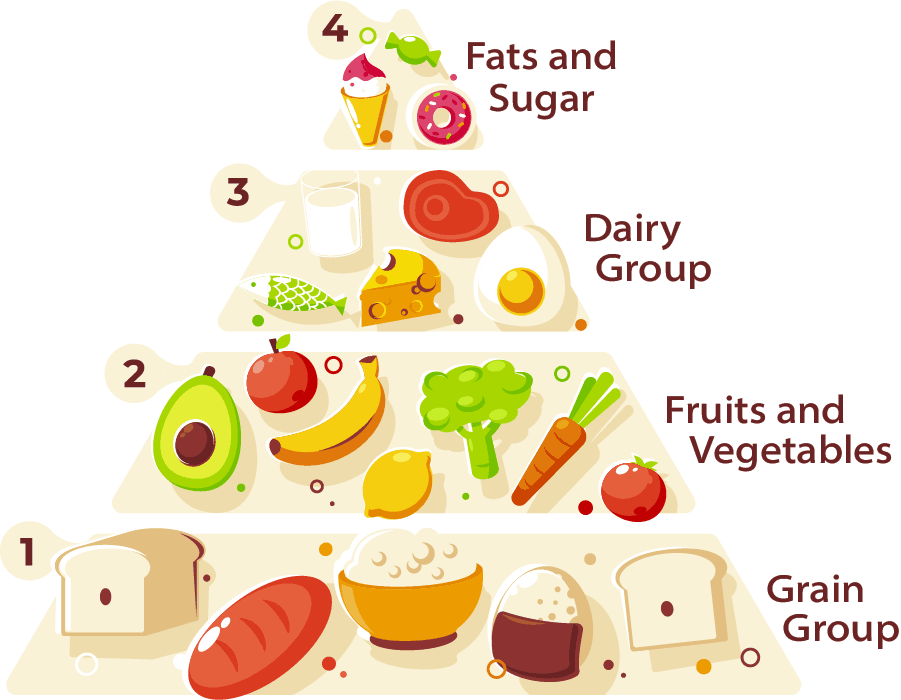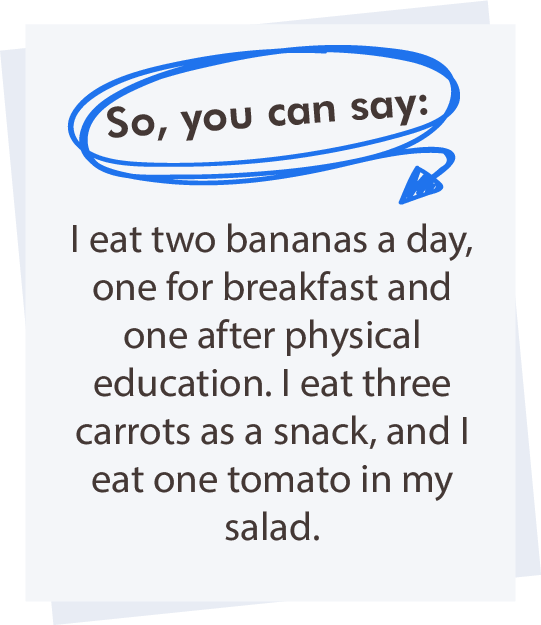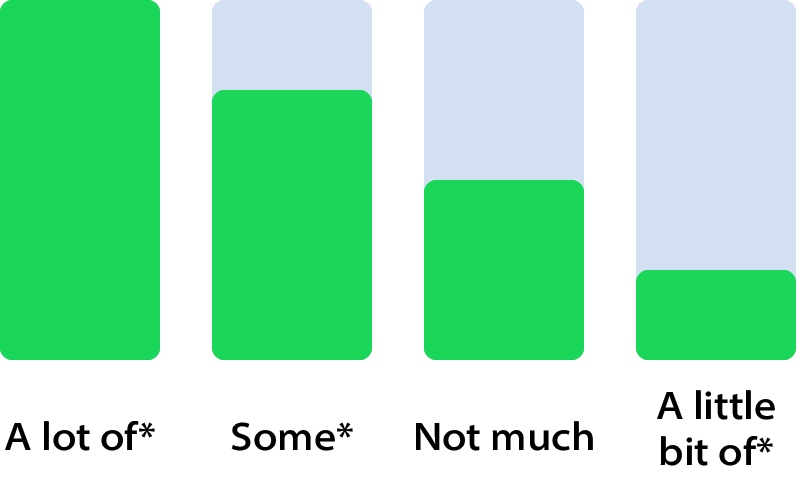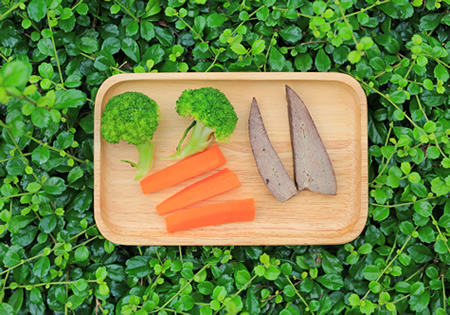1- Talking about food
Have you heard of the food pyramid? The food pyramid is a diagram that helps people organize and prioritize the foods according to their nutrients. It concentrates on daily intakes (the food you need to consume daily). This means it helps us know what type of foods are ideal for a healthy life. The food items at the bottom are the most important. The food items at the top are the least important.

Let’s have a look at each category:
|
The first category, The Grain Group |
The second category, Fruits and Vegetables |
The third category, Dairy Group |
The fourth category, Fats and Sugar |
|
Toasts Bread Oatmeal Rice |
Avocado Apple Banana Lemon Broccoli Carrot Tomato |
Milk Fish Cheese Beef Eggs |
Candy Ice cream Doughnut |
The food pyramid is only a recommendation. But if you want to be healthy, here is a comment from Matthew, a 13-year-old boy. He wants to be a nutritionist when he grows up, he is very informed! Pay attention to what he eats in a day.

Hi, I’m Matthew. In a normal day I have two toasts and butter, and some milk. For lunch, I eat some beef and some broccoli, with a little bit of rice, and one apple or one banana for dessert. For dinner, I have some fish and three carrots and a little bit of avocado. I need to eat healthily, so I have energy to study!
2- Expressing quantities
2.1- What do you eat in a day?
In English, to express quantity, we use a group of special words called quantifiers. Quantifiers can be as simple as numbers, or as complex as quantity words.
We use numbers with countable nouns. Countable nouns are things that we can count in an exact quantity, for example, all the items colored in green. Have a look at the different groups from the food pyramid. All these green food items are countable nouns, because we can express their exact number.
There are many countable nouns, but below is the list from the food pyramid:
- Toasts
- Avocado
- Apple
- Banana
- Lemon
- Carrot
- Tomato

If you have a look at the elements in blue, you notice that these are uncountable nouns. The type of quantifiers we use are quantity words, because we can’t tell the exact number of these foods. Matthew used some, and a little bit of. But we have some more.
First, let’s see the list of uncountable nouns from the food pyramid
- Bread
- Oatmeal
- Rice
- Avocado
- Broccoli
- Milk
- Fish
- Cheese
- Beef
- Candy
- Ice cream
Second, let’s see some quantity words. We can’t tell the exact number of an uncountable noun, but we can give an approximate:

*We can also use these words with countable nouns, but let’s focus on uncountable nouns.
For example:
In my birthday, I have a lot of candy! I love candy!

| A lot of, refers to a big quantity. If you look at the picture, you see lollypops, cakes, cookies, a lot of candy! |
I have some milk with my coffee every morning, coffee alone is too strong!

| Some, refers to a quantity that is not too big and not too small. If you look at the picture you see that the person is pouring (adding) a reasonable amount of milk. |
I like vegetables for dinner, some beef and broccoli, but not much broccoli, I prefer a little bit of avocado.

| Not much, refers to a small quantity a little bit refers to a very, very small quantity. If you look at the picture you see that the person is pouring (adding) a reasonable amount of milk. |
In conclusion, we use numbers to express quantity in countable nouns, and we use quantity words with uncountable nouns.
We can say "I eat 3 carrots a day", but we can’t say "I eat 2 beefs a day". We can’t say "I have 3 milks in the morning", but we can say "I have some milk in the morning".

Before we continue, here is a Spanish summary:
En inglés se clasifican ciertos elementos en contables y no contables. Cuando tenemos elementos contables, podemos utilizar números exactos para expresar cantidad (los elementos en verde a lo largo de esta lección). Para expresar cantidad con elementos no contables (los elementos en azul a lo largo de esta lección), utilizamos "palabras cuantificadoras" como "a lot of" (mucho) "some" (algo de…), ‘not much’ (no mucho/no mucho de…), y "a little bit of" (un poco de…).
3- What’s in your kitchen? Expressing existence
Do you remember Matthew? He is a very healthy boy. His family kitchen is full of food. Let’s see what he has in his kitchen.

| We go to the supermarket every two weeks. In my fridge there are ten apples, 6 carrots, 6 doughnuts, and 24 eggs, among others. There is some bread and there is some milk. There are ten lemons for salad, and there is a little bit of fish in the freezer. There is one tomato too. |
As you can see, he uses some phrases to indicate that something exists in the kitchen. "there is", and "there are" are phrases we use in English to say that something exists in a place.
We use There is (There’s) with singular countable nouns and with uncountable nouns.
We use There are (There’re) with plural countable nouns only.
|
There is |
|
|
|
There are
|
|
|

Before we move on, here is a Spanish summary:
En inglés utilizamos “There is” y “There are” para hablar de la existencia de cosas en un lugar específico. Ambas frases significan “hay”, la diferencia está en su uso. Utilizamos “There is” antes de elementos contables singulares (solo uno de ellos), y antes de elementos no contables: Hay una manzana en mi mesa (There is one apple in my table); Hay un poco de leche en el refrigerador (There is a little bit of milk in the fridge). Utilizamos “There are” solamente con elementos contables en plural (más de uno de ellos): Hay 6 zanahorias sobre la mesa de la cocina (There are six carrots on the kitchen table).
4- Asking what others have in their kitchen
You need questions to start conversation with other people about what they eat during the day. Have a look at this conversation. Matthew and her friend Tammy are talking about their week.

Matthew: Hey Tammy, How much milk do you drink in a week?
Tammy: Hey Matthew, I don’t drink any milk. I’m a vegan. I only drink some natural juice and two avocado toasts.
Matthew: Interesting! But, Are there any eggs in your fridge?
Tammy: Sure! They are. I am the only vegan in the family.
Matthew: Interesting! But, how many eggs are there in your fridge?
Tammy: Oh! There are 24 eggs in my fridge. Is there any beef in your fridge?
Matthew: Yes! My dad loves BBQs. We do family barbecues every Sunday.
Tammy: I see… But, how much beef is there in your freezer?
Matthew: Oh, there is a lot of beef in my kitchen!
4.1- Short questions need short answers
When we ask about existence, we use there is or there are. For simple answers, we use these kind of questions:
a. We use "there is" to ask about the existence of uncountable nouns. We include the word "any".
We swap the position  of there :
of there :
Is there + any + uncountable noun + place
Example:
Is there any milk in your fridge?
Yes, there is some milk in my fridge.
No, there isn’t any milk in my fridge.
b. We use "there are" to ask about the existence of countable nouns. We include the word ‘any’.
We swap the position  of there are:
of there are:
Are there + any + countable noun + place
Example:
Are there any eggs in your fridge?
Yes, there are 24 eggs in my fridge.
No, there aren’t any eggs in my fridge.
‘Any’ means ‘undetermined’ it’s the English for the Spanish ‘algún/algo de…’ we use any in simple questions all the time. But we only use it with negative answers, when something is not present.

| See? Answers are just a simple sentence, normally repeating what the question says. |
4.2- Long questions need long answers
a. Asking questions using "how much"
We use how much in a question that asks for the approximate quantity of uncountable nouns.
Don’t forget we swap the position  of there is and there are accordingly.
of there is and there are accordingly.
Example:
How much milk is there in your fridge?
There is some milk in my fridge.
There isn’t any milk in my fridge.
This is the structure you need:
How much + uncountable noun + is there + place
Examples:
How much bread is on your kitchen table?
How much avocado is on your plate?
How much ice cream is in your birthday bowl?
b. Asking questions with "how many"
We use how many in questions that ask for the exact number of countable nouns.
How many doughnuts are there in your kitchen?
There are 8 doughnuts in my kitchen.
There aren’t any doughnuts in my kitchen.
This is the structure you need:
How many + plural countable noun + are there + place
Examples:
How many carrots are there in the bag?
How many toasts are there in the left drawer?
How many lemons are there in the fruit container?

Last bit of Spanish:
Utilizamos "How many" y "How much" para preguntar cuánto(s) ó cuánta (s) elementos hay en un determinado lugar. Utilizamos "how many" con sustantitivos contables y "how much" con sustantivos no contables. "Any" se utiliza como ‘algún/a- algo de…’ en preguntas y se utiliza como "nada de" solamente en respuestas negativas.

